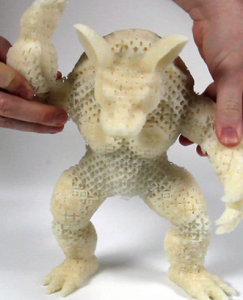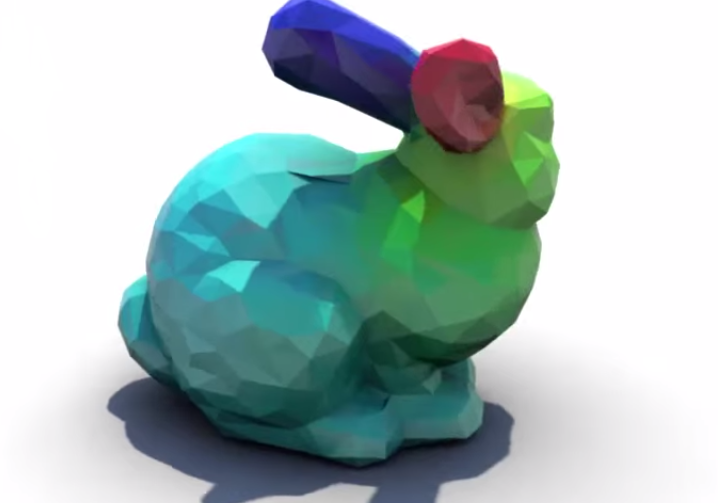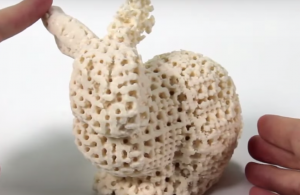 Disney Research, not surprisingly, is bringing their latest project home with some new 3D printed materials that are unlike anything we’ve ever seen, even perhaps bordering on–dare we say it?–the magical. In a vein of work that we all know most certainly would have had Walt hoppin’ with excitement, researchers have made a discovery that in one fell swoop exponentially increases all of the benefits that excite manufacturers so much about the technology of 3D printing. They’ve discovered that from using just one 3D printing material they can vary the amount of elasticity and movement in one 3D object rolling off the printer.
Disney Research, not surprisingly, is bringing their latest project home with some new 3D printed materials that are unlike anything we’ve ever seen, even perhaps bordering on–dare we say it?–the magical. In a vein of work that we all know most certainly would have had Walt hoppin’ with excitement, researchers have made a discovery that in one fell swoop exponentially increases all of the benefits that excite manufacturers so much about the technology of 3D printing. They’ve discovered that from using just one 3D printing material they can vary the amount of elasticity and movement in one 3D object rolling off the printer.
With these new findings and resulting examples, all the reasons we find 3D printing great for production purposes become even greater with further massive potential and previously unheard-of customizations, efficiency and simplicity in workflow, and savings on the bottom line in production.  For Disney, their example is appropriately demonstrated in the production of stuffed animals–no longer your average little bears or bunnies or robot characters. In using what could clearly define groundbreaking new material, as well as changing the manufacturing of such figures for good, researchers are showing off a way to develop ‘families’ of microstructures that offer varying degrees of elasticity in one teddy bear.
For Disney, their example is appropriately demonstrated in the production of stuffed animals–no longer your average little bears or bunnies or robot characters. In using what could clearly define groundbreaking new material, as well as changing the manufacturing of such figures for good, researchers are showing off a way to develop ‘families’ of microstructures that offer varying degrees of elasticity in one teddy bear.
Basically, although a family of microstructures are essentially cut from the same cloth, they are able to be markedly different in terms of mobility, and this can be cut down to size even further, demonstrating that all of the 3D printed parts that are responsible for constructing one item such as a teddy bear can do different things–so all in one teddy bear one could feasibly observe moving, bending limbs, a soft middle, and a stiff head structure.
“Many functional objects in our everyday life consist of elastic, deformable material, and the material properties are often inextricably linked to function,” said Christian Schumacher, a PhD computer graphics student at ETH Zurich and at Disney Research. “3D printing usually involves only a single material or a very small set of materials. However, 3D printing easily produces complex, 3D microstructures which we can use to create metamaterials with properties beyond those of standard printer materials.”
Schumacher and his team worked with the metamaterials, which change their shape and properties depending on their structure. They found that the key was in arranging microstructures with the appropriate properties and using a variety of them so that one construction could have varying elastic properties due to the different regions all found within its one piece. This was all achieved through creating and calculating unique algorithms which were then used in designing the tiled microstructures.
“To create an object with spatially varying elastic properties, we tile the object’s interior with microstructures drawn from these families, generating a different microstructure for each cell using an efficient algorithm to select compatible structures for neighboring cells,” explained the Disney research team in their publication regarding the microstructures.
With just a “single base material” they are also able to demonstrate their innovation in materials with a soft armadillo toy that is basically an aesthetic covering functioning due to the microstructures within that offer the varying elastic abilities.
“Our method tackles two basic problems,” states the team. “First, we approach the question of how to efficiently generate the structure for given elastic behavior. During pre-processing, we build a data-driven model that can generate such structures. We then look at the problem of how to combine multiple distinct structures inside a single object. This enables us to generate objects with spatially varying properties.”
 With the example of a bunny, they were able to specify virtual descriptions such as one soft ear and one stiff ear, along with varying elastic properties throughout the rest of the body. They were able to construct a 3D model from this for printing. A teddy bear demonstrates similar qualities in that one leg is softer and more pliable than the other. The armadillo is unique in that it demonstrates soft regions around the arms, legs, torso, and neck–while the rest of the figure’s body is rigid. This allows for an articulated character without any actual mechanical parts. Using the same algorithm, they also designed a soft robot, centered around a sheath that was rolled into a tube to create a long robotic finger for gripping objects.
With the example of a bunny, they were able to specify virtual descriptions such as one soft ear and one stiff ear, along with varying elastic properties throughout the rest of the body. They were able to construct a 3D model from this for printing. A teddy bear demonstrates similar qualities in that one leg is softer and more pliable than the other. The armadillo is unique in that it demonstrates soft regions around the arms, legs, torso, and neck–while the rest of the figure’s body is rigid. This allows for an articulated character without any actual mechanical parts. Using the same algorithm, they also designed a soft robot, centered around a sheath that was rolled into a tube to create a long robotic finger for gripping objects.
“After choosing a set of structures, we combined them to create a model that we could 3D print. We used our models to generate and print a number of examples.”
 Building the family of properties with similar structures was key, and allowed the researchers to create a “continuous base of structures,” leading to success in the project. Each microstructure measures 8 mm on a side and all different shapes had to be connected properly.
Building the family of properties with similar structures was key, and allowed the researchers to create a “continuous base of structures,” leading to success in the project. Each microstructure measures 8 mm on a side and all different shapes had to be connected properly.
Schumacher and his team will be discussing their findings on this subject next week in Los Angeles at ACM SIGGRAPH 2015, held August 9-13.
Discuss your thoughts on these new findings in materials research in the 3D Printed Objects with Varying Elasticities forum thread over at 3DPB.com. Check out the video below demonstrating and explaining the concept.
Subscribe to Our Email Newsletter
Stay up-to-date on all the latest news from the 3D printing industry and receive information and offers from third party vendors.
You May Also Like
Precision at the Microscale: UK Researchers Advance Medical Devices with BMF’s 3D Printing Tech
University of Nottingham researchers are using Boston Micro Fabrication‘s (BMF) 3D printing technology to develop medical devices that improve compatibility with human tissue. Funded by a UK grant, this project...
3D Printing Webinar and Event Roundup: April 21, 2024
It’s another busy week of webinars and events, starting with Hannover Messe in Germany and continuing with Metalcasting Congress, Chinaplas, TechBlick’s Innovation Festival, and more. Stratasys continues its advanced training...
3D Printing Webinar and Event Roundup: March 17, 2024
It’s another busy week of webinars and events, including SALMED 2024 and AM Forum in Berlin. Stratasys continues its in-person training and is offering two webinars, ASTM is holding a...
3D Printed Micro Antenna is 15% Smaller and 6X Lighter
Horizon Microtechnologies has achieved success in creating a high-frequency D-Band horn antenna through micro 3D printing. However, this achievement did not rely solely on 3D printing; it involved a combination...






























